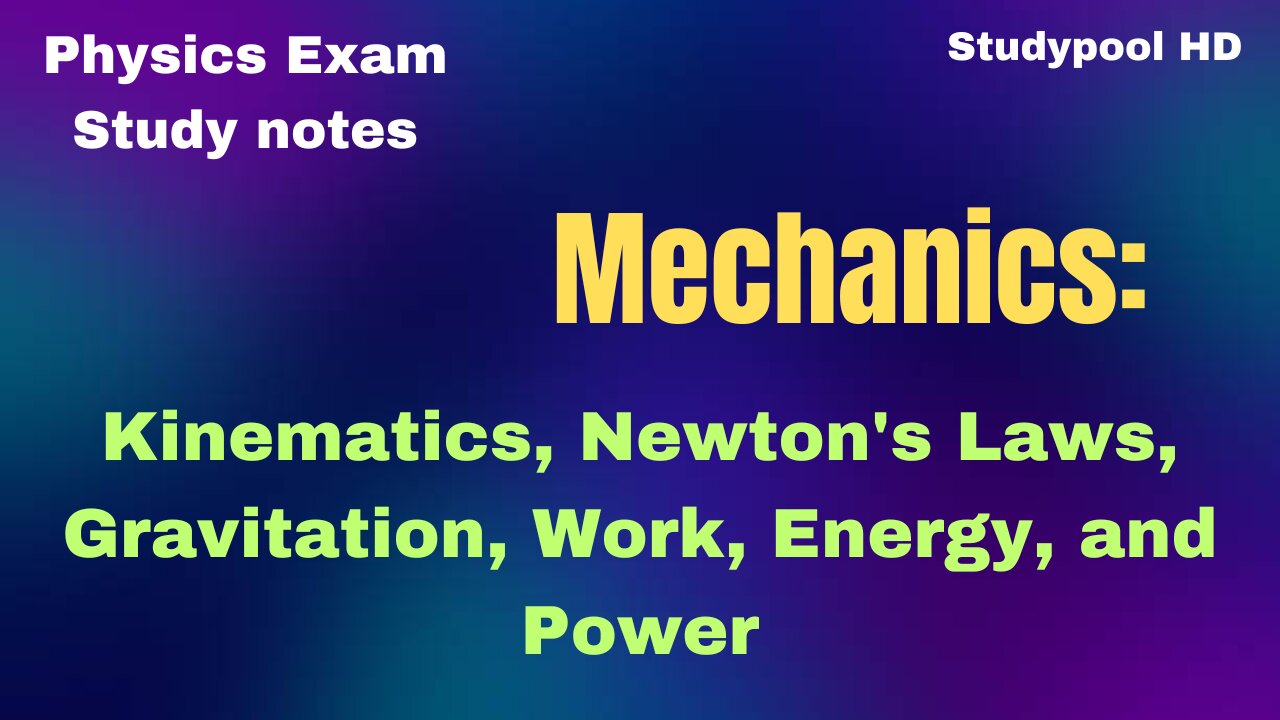Premium Only Content

Physics Mechanics Kinematics Newton's Laws Gravitation Work Energy and Power | silverfoxnews
Mechanics
Kinematics Newton's Laws Gravitation Work Energy and Power
Mechanics
Mechanics is a fundamental branch of physics that deals with the study of motion and the forces that cause it. It encompasses various subtopics, including kinematics, the laws of motion, gravitation, and the concepts of work, energy, and power.
Kinematics
Definition: Kinematics is the branch of mechanics that describes motion without considering the causes of motion (i.e., forces). It focuses on the mathematical description of objects in motion.
Key Equations:
Distance, Speed, and Time:
Distance (d) is the length of the path traveled by an object.
Speed (v) is the rate of change of distance with respect to time.
Time (t) is the duration of motion.
Equation: Distance = Speed x Time (d = vt)
Velocity:
Velocity (v) is a vector quantity that includes both magnitude (speed) and direction. It represents the rate of change of displacement with respect to time.
Equation: Velocity = Change in Displacement / Time (v = Δx / Δt)
Acceleration:
Acceleration (a) is the rate of change of velocity with respect to time. It can be positive (speeding up), negative (slowing down), or zero (constant velocity).
Equation: Acceleration = Change in Velocity / Time (a = Δv / Δt)
Newton's Laws of Motion
1. First Law - Law of Inertia:
An object at rest will remain at rest, and an object in motion will remain in motion at a constant velocity unless acted upon by an external force.
2. Second Law - F = ma:
The force (F) applied to an object is directly proportional to the mass (m) of the object and the acceleration (a) it experiences. This relationship is expressed as F = ma.
3. Third Law - Action and Reaction:
For every action, there is an equal and opposite reaction. When one object exerts a force on another object, the second object exerts an equal force in the opposite direction.
Gravitation
Definition: Gravitation is the branch of mechanics that deals with the study of the gravitational force of attraction between objects with mass.
Key Equations:
Universal Law of Gravitation:
Every object with mass attracts every other object with mass through a force called gravitational force.
The force (F) is directly proportional to the product of the masses (m1 and m2) and inversely proportional to the square of the distance (r) between them.
Equation: F = G * (m1 * m2) / r^2
Weight:
Weight (W) is the force with which an object is pulled towards the center of the Earth (or any other celestial body).
Weight is calculated using the formula: Weight = mass (m) x gravitational acceleration (g).
Equation: Weight = mg
Work, Energy, and Power
Definition: Work, energy, and power are concepts that describe the transfer and transformation of energy in various physical processes.
Key Equations:
Work (W):
Work is done when a force is applied to an object, causing it to move a certain distance against the force.
The work done (W) is given by the product of the force (F), the displacement (d), and the cosine of the angle (θ) between the force and displacement vectors.
Equation: Work = Force x Displacement x cos(θ)
Kinetic Energy (KE):
Kinetic energy is the energy possessed by an object due to its motion.
The kinetic energy (KE) of an object with mass (m) and velocity (v) is given by the formula: KE = 0.5 * m * v^2.
Potential Energy (PE):
Potential energy is the energy associated with an object's position or condition.
For objects near the Earth's surface, gravitational potential energy (PE) is given by the formula: PE = m * g * h, where h is the height above a reference point.
Power (P):
Power is the rate at which work is done or energy is transferred.
The power (P) of a process is calculated by dividing the work (W) by the time (t) it takes to perform the work.
Equation: Power = Work / Time (P = W / t)
Understanding these fundamental principles of mechanics is essential for analyzing and predicting the behavior of objects in motion, as well as the forces that influence them. These concepts play a crucial role in various scientific and engineering applications.
-
 LIVE
LIVE
Barry Cunningham
5 hours agoTRUMP DAILY BRIEFING: KASH PATEL VOTE | WHITE HOUSE PRESS CONFERENCE | DOGE UPDATE
1,999 watching -

The Quartering
3 hours agoRand Paul Praises Trump, Amazon Takes Control of Bond, and Delta Gives Passengers $30,000
33.1K13 -
 1:01:59
1:01:59
The White House
2 hours agoPress Secretary Karoline Leavitt Briefs Members of the Media, Feb. 20, 2025
33.5K15 -
 59:58
59:58
Russell Brand
4 hours agoLive from Mar-a-Lago: The Globalist Empire’s Last Stand – SF541
90.2K65 -
 35:23
35:23
CryptoWendyO
1 hour ago $0.62 earnedCrypto Chaos Unleashed: Trump Making USA The Bitcoin Capital Of The World
4.66K -
 1:03:00
1:03:00
The Dan Bongino Show
5 hours agoTrump Keeps Delivering And The Libs Are Seething (Ep. 2427) - 02/20/2025
660K1.47K -
 1:20:26
1:20:26
Nerdrotic
3 hours ago $3.88 earnedSuper Chat Square Up - Nerdrotic Nooner 466
52.2K1 -
 2:05:00
2:05:00
Steven Crowder
6 hours agoTrump Slams Dictator Zelensky: Why He NOW Has a Point
433K262 -
 2:58:22
2:58:22
LFA TV
18 hours agoKASH CONFIRMATION & PRESS BRIEFING! | LIVE FROM AMERICA 2.20.25 11AM
89.9K33 -
 2:14:42
2:14:42
Matt Kohrs
14 hours agoIt's A Bull Trap, Partner! || The MK Show
82.7K3